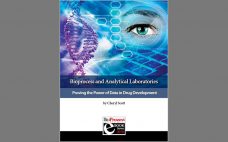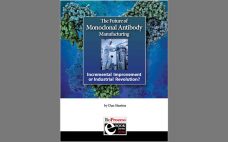Welcome to this year’s focus on industry training programs. In the past three years we’ve brought this information to you in several forms: as a full supplement issue (2016), a featured report (2017) – and now this ebook. Each program that we’ve profiled offers its unique approach to training present and future biotechnologists. The best of the programs offer hands-on training with current equipment provided by supplier partners and with up-to-date approaches to documentation and regulatory requirements. Many university- and…
eBooks
eBook: Manufacturing CAR-T Cell Therapies — Insights and Challenges
The rapid evolution and clinical success of T-cell immunotherapies is an exciting advance in the war on cancer. This treatment modality uses engineered cells from a patient’s own immune system to target and destroy cancerous cells. Chimeric antigen receptor T-cell (CAR-T) therapy is emerging as the most studied treatment in T-cell immunotherapy and is the basis for many ongoing clinical trials. FDA approval of the first two CAR-T therapies in 2017 provides a regulatory development framework, but optimization of CAR-T…
Accelerating Intensified Bioprocesses with High-Throughput Small-Scale Tools
While many biopharmaceutical companies are exploring paths toward continuous processing, many tools already exist for implementing process intensification. As the authors of this special report illustrate, hybrid continuous processes that benefit from single-use technologies along with continuing improvements in perfusion cell culture already now are enabling improvements in cost reduction and accelerating time to market. And novel high-throughput and automated small-scale systems are helping development scientists gather more information in less time than before, reduce their development footprints, and make…
PDB-Dimer Payloads for Antibody Drug Conjugates: A Robust Approach to cGMP Production
From the 1960s when monomeric pyrrolobenzodiazepines (PBDs) such as anthramycin were isolated and characterized, to the dramatic increase of potency induced by dimerization in the 2000s, PBD dimers have evolved as one of the leading classes of antibody drug conjugate (ADC) payloads. Currently, 17 ADCs are in clinical trials involving PBD-dimers — second only to auristatins (23 ADCs), and more than those with maytansines (16 ADCs). Four different PBD-dimer ADC payloads are in clinical trials: Talirine (SGD-1910) from Seattle Genetics;…
eBook: Quality By Design for Monoclonal Antibodies — Establishing the Foundations for Process Development, Design Space, and Process Control Strategies
The quality by design (QbD) modernized approach to pharmaceutical development is intended to provide regulatory flexibility, increased development and manufacturing efficiency, and greater room to innovate as well as improve manufacturing processes within defined ranges without obtaining regulatory approval first. QbD is a systematic developmental approach that starts with a clear goal in mind and emphasizes understanding of how variability in both process and materials affects a final product (1). Historically, product quality has been assured either with end-product testing…
eBook: Raw Materials Quality, Processing, and Storage — A Manufacturing Case Study
Raw material storage, handling, and processing are essential to ensure high product quality and consistent process performance. Slight variabilities in raw materials (either inherent in the material or through processing) can compromise yield and even result in batch loss. On Tuesday 26 September 2017 speakers at the BioProcess International Conference (part of Biotech Week Boston) addressed raw material variability and control strategies in biomanufacturing. They discussed the industry’s initiative for raw material risk assessments and strategies to control variability by…
eBook: SUStainability — Concerning Single-Use Systems and the Environment
Disposable materials have been used in many aspects of biomanufacturing since muromonab was first launched in 1986. Single-use stirred-tank bioreactors first became commercially available from HyClone in 2004 (1). Despite their demonstrated value to bioprocessing, disposable materials remain the subject of wide-ranging differences of opinion. Discussions of any technology are healthy and important for identifying areas for improvement, but some hearsay and bold propositions made regarding single-use components and the environment are not always helpful. Sustainability is an important and…
eBook: Bioprocess and Analytical Laboratories — Proving the Power of Data in Drug Development
Analytics pervade the entire biopharmaceutical development process — from protein characterization through biomanufacturing process optimization to final-product formulation and clinical testing. Every technical article in BPI requires data to back up the statements made, whether the topic is upstream/production, downstream processing, product development, or otherwise focused. And never mind publishing: Even more detailed documentation is required for regulatory submissions. If a company can’t back up the choices made and results obtained in development, manufacturing, and testing of its biopharmaceutical product,…
eBook: The Future of Monoclonal Antibody Manufacturing — Incremental Improvement or Industrial Revolution?
Monoclonal antibody manufacturing is at a crossroads. Biomanufacturers could continue exploring new technologies and fine-tuning proven systems such as mammalian cell expression systems in stirred-tank bioreactor fed-batch cultures. But some experts say an opportunity is arising to turn the industry on its head by taking lessons from other branches of bioprocessing, such as the industrial enzyme sector. Drug makers are criticized often these days for the high prices of their products. The lay media, governments, payers, and patients themselves all…
eBook: Development and Application of a Simple and One-Point Multiparameter Technique — Monitoring Commercial-Scale Chromatography Process Performance
In commercial-scale biopharmaceutical manufacturing, downstream chromatography steps are still a bottleneck and contribute to significant operational costs (1, 2). Some of those costs are inherent (e.g., resins, large buffer quantities, and cleaning) whereas others are avoidable (e.g., product loss due to rejected lots or deviations that result in production downtime). Maintaining efficient and robust chromatography process performance is therefore critical for minimizing operating costs. To do so, we introduce a simple and one-point multiparameter technique (SOP-MPT) for monitoring chromatographic process…










